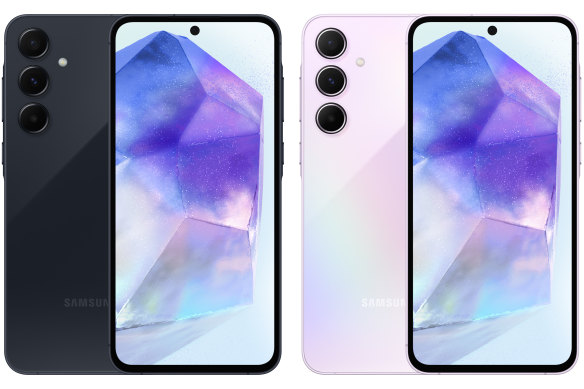
On the other side of the camera equation, selfies are generally sharp, but fall a bit flat in the colour department, while I’m not sure why a dedicated macro is included at all aside from the optics of having three lenses on the back of the phone. There is no telephoto lens to speak of, so if you zoom you’re essentially just getting a digital crop from the main camera. Some phones pull this off fine, but zooms are blurry and grainy on the A55. I also found all lenses suffered from grain in lighting conditions that were less than ideal but not low enough to trigger night mode, which does a reasonable job of boosting colours and smoothing things out.
The A55 uses the latest version of Samsung’s One UI flavour of Android, though you shouldn’t expect any of the recent AI innovations included in its more expensive phones. It’s possible there are hardware limitations that keep Galaxy AI off these less capable phones, but it still feels bad not to have the latest software capabilities, especially when the likes of Google manage to trickle its AI photo editing and voice assistant features down to its least expensive Pixel phones. Samsung does promise five years of updates with the A55, so it’s possible AI smarts will come down the line.

The A55 only comes in “navy” and “lilac”.
Elsewhere, there is a range of niggles that aren’t unusual for lower-priced phones but add up to make an overall less smooth experience compared with some other options. For example, the A55 does not have a proximity sensor and so can only guess when you’re holding the phone near your face to talk on it, which in my testing meant the screen sometimes stayed on and let my face press buttons. The metal frame also has quite a harsh edge where it meets the glass, making for an uncomfortable hold if you’re not using a case. There’s no wireless charging, and wired is limited to 25W, so you won’t get a whole lot of juice out of a quick emergency charge.
How does it stack up?
Compared with the highest of high-end phones like the Galaxy S24 Ultra or the iPhone 15 Pro Max, it would be easy to say the A55 offers the bulk of the flagship experience at a third of the price. Sure, you don’t get the titanium frame, fancy always-on LTPO display, zoom lenses, wireless charging or cutting-edge processors you get on those $2200 phones, and Samsung isn’t pushing AI features on the A55 like it is at the high end, but those are perfectly fine sacrifices for most people. The more difficult comparison is with other phones in the price bracket, which include Chinese flagships that outperform the A55, and older iPhones that can still keep up.
Loading
In fact, the $700 mark is currently a difficult place for a smartphone to be. Take a look at any retailer and you’ll find many phones with specifications similar to the A55 going for about $550, including Google’s AI and photography powerhouse Pixel 7a, Samsung’s Galaxy A35, Xiaomi’s Redmi Note 13 and the Nothing Phone 2a (which in Australia is exclusive to JB Hi-Fi). Like the A55, they all have big screens with high refresh rates, multiple cameras and water resistance ratings.
Many competitors are pushing hard to get their mid-range phones to flagship level in certain areas that Samsung isn’t interested in for its A5 series, such as fast-charging, slimmer display bezels and zoom lenses. And penny-pinchers might also simply look for last year’s A54, a very similar phone in everything but performance and battery life.
Meanwhile, if you were looking to spend a little bit more, you could get an objectively stronger phone from a year ago such as the iPhone 14 or Samsung’s Galaxy S23 FE, which are often seen under $1000.
Overall, the A55 is a great phone, but is playing it very safe given how competitive the mid-range space has become.
Get news and reviews on technology, gadgets and gaming in our Technology newsletter every Friday. Sign up here.



























